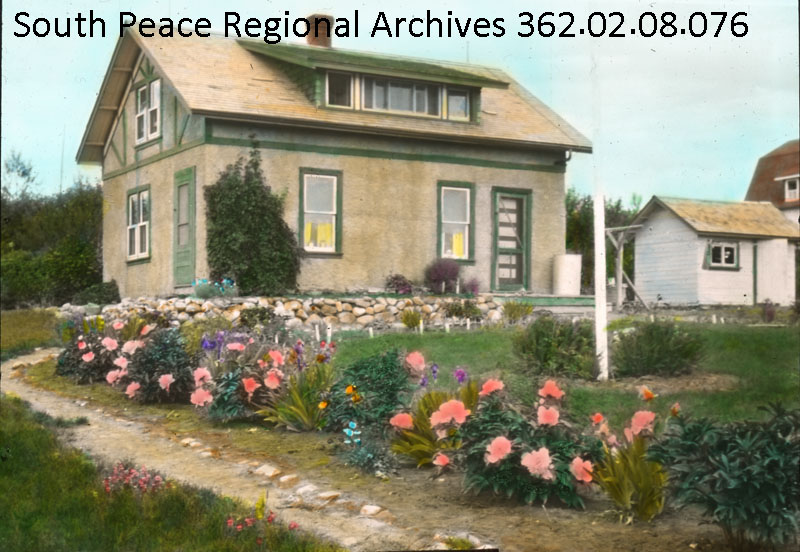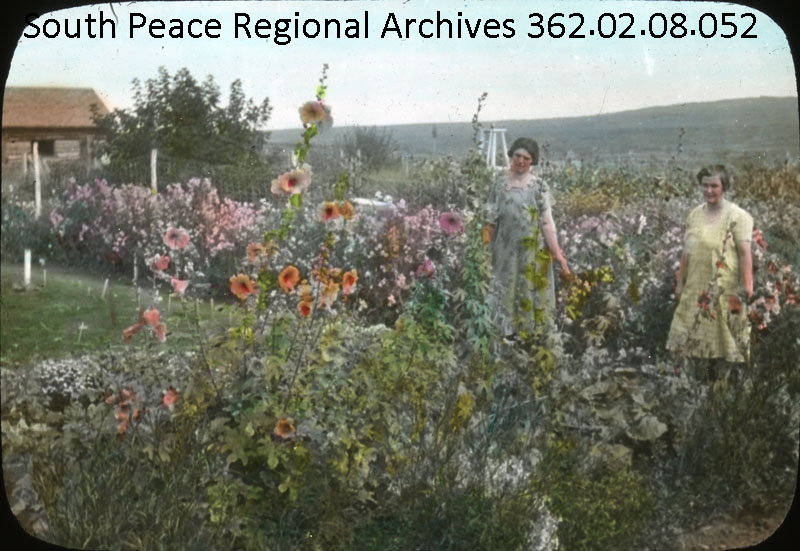Image: Hollyhocks blooming in September on outdoor-wintered roots, Beaverlodge. Photographed by W. D. Albright. 1926. (SPRA 362.02.08.052)
William Donald (W.D.) Albright arrived in Beaverlodge in 1913 and filed on homestead with his wife and children. Albright established the Beaverlodge Dominion Experimental Sub-station in 1917 and committed decades to researching the suitability of crops in the area. He frequently toured the Peace River country, promoting his research through public lectures and social visits. On 9 August 1935, Albright addressed the Grande Prairie District Women’s Institute Convention with a lecture titled: Landscaping the Home Grounds.
A Modest Frame for a Modest Home
The grounds should, in landscaping, be regarded as the frame of the picture; the house as the subject to be framed; therefore, the house itself should be designed to suit the region in which it is built, and usually in the country it will be best if it rather hugs the landscape instead of standing up bold and assertive…
Coming, however, to the question of the grounds themselves, we may say that for somewhat different reasons these also should be moderate in extent. It will soon be found by one attempting to make lawns, to plant trees, to grow flowers and shrubbery in a cold, semi-arid climate, that more work is required to obtain a given result than in more temperate climates with ample rainfall or perhaps with a hose of water to be played at will. If too much is attempted neglect is almost certain to follow…
Far better to attempt a little and do it well. When in doubt how large to make the lawn or how extensive the grounds, err on the safe side….
Plan, Criticize, & Revise
The second point I would emphasize with all the force at my command is pre-planning…. It is easier to change a drawing then to transplant a tree, and set-back is avoided….
Having ascertained the probable hardiness, size, blooming habits and other characteristics of the material to be used, draw a plan of the grounds to scale with buildings, both house and out-buildings, accurately placed, then using initial letters, pencil in the position of the different things it is proposed to use, commencing with the windbreak. Study this plan, pondering it day by day. Take it outdoors and try to visualize the future effect. Some things occur when looking at the grounds that do not strike one equally from mere study of a paper plan. Show the plan to your friends and to any experienced gardeners who may come along, and finally submit it for criticism to some source of public information….
Take Advantage of Natural Features
It is a first principle in landscaping to take advantage of natural features. Is there a creek running past the place which may be fitted into the scheme of things? Is there a depression where a sunken garden may be created and made to succeed? Is there a rolling swell on which the house itself is situated? Is there an attractive vista in this direction or that? Let these things be studied and made the most of. Man’s highest art in landscaping is not to violate Nature but to utilize her; to study natural features and make the most of them….
This article first appeared in the June 2019 issue of Telling Our Stories. The rest of the article will be featured on the blog on the first Wednesday of next month.

